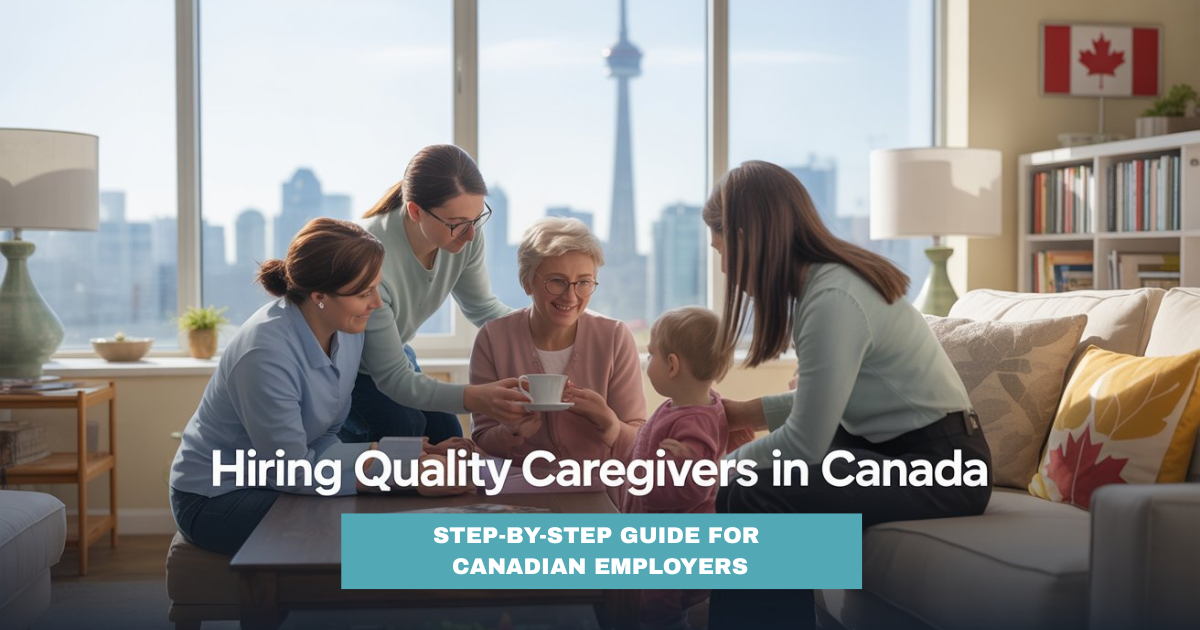
Hiring Quality Caregivers in Canada: Step-by-Step Guide
Hiring quality caregivers in Canada is a crucial decision for Canadian employers seeking reliable, compassionate, and compliant care support. This guide breaks down the entire process—from legal prerequisites to recruiting, onboarding, and retention—so you can confidently navigate every stage. By following this step-by-step guide, you’ll reduce risk, ensure compliance, and find caregivers who enhance quality of life for care recipients.
Why Canadian Employers Are Prioritizing Quality Caregiving
Canada faces a caregiving crisis: over 8 million Canadians provide unpaid care worth nearly $97 billion in value, and 1 in 4 caregivers report poor mental health and financial strain. Meanwhile, demand for paid caregivers—home support workers (NOC 44101) and home child care providers (NOC 44100)—is surging, driven by an aging population. Amid caregiver burnout and high turnover, Canadian employers must be strategic about hiring quality caregivers in Canada.
Step 1: Understand the Legal Framework
1.1 Temporary Foreign Worker Program (TFWP) / LMIA
For non‑Quebec employers, a positive Labour Market Impact Assessment (LMIA) is essential when hiring foreign caregivers via the TFWP.
This includes:
- Offering full‑time, permanent employment (min. 30 hrs/week) under NOC‑44100/44101.
- Demonstrating recruitment attempts to hire Canadians.
- Paying provincial median wage or higher.
1.2 Home Care Worker Immigration Pilots
New Pilots launched March 31, 2025, bypass LMIA for caregivers, offering permanent residence upon arrival.
Requirements include:
- Valid job offer full‑time outside Quebec.
- Language proficiency (CLB 4+).
- Equivalent to Canadian high school diploma.
1.3 Business Number & Payroll Obligations
Employers must register for a Canada Revenue Agency Business Number (BN) and a separate payroll account. This covers tax deductions, EI, and CPP contributions. A Record of Employment (ROE) is mandatory upon employment interruptions.
Step 2: Plan and Prepare
2.1 Define the Role
Draft a job description with duties (e.g., medication support, meal prep), working hours, live‑in vs. live‑out status, salary, benefits, and required NOC code.
2.2 Budget and Financial Assessment
Calculate total costs: salary, benefits, taxes, agency fees (if applicable), and LMIA processing (approx. $1,000 CAD). Use your latest Notice of Assessment (NOA) to prove financial ability canada.ca.
2.3 Advertising and Candidate Sourcing
Advertise widely—Canada Job Bank, provincial sites, caregiver agencies, community boards. Document efforts to recruit Canadians (required for LMIA).
Step 3: Recruit and Evaluate
3.1 Screening Applicants
Shortlist candidates based on:
- Language skills (English/French CLB 4+).
- Experience in home or child care.
- Education credentials or ECA, if international.
3.2 Interview Process
Use structured interviews. Ask situational questions like:
- “Describe how you handle care-resistant dementia patients.”
- “How do you manage stress or back‑up care?”.
If using an agency, verify credentials, background checks, references, and criminal record.
Step 4: LMIA & Work Permits (if applicable)
4.1 LMIA Submission
Submit LMIA application with contract, NOA, proof of recruitment, and BN. Processing takes ~60 days and costs CAD $1,000.
4.2 Caregiver Work Permit
Once LMIA is positive, the caregiver applies for a work permit at IRCC. Processing takes about 9 weeks (plus eTA if required).
4.3 Pilot-Based Permanent Residence
If hiring under the 2025 Home Care Worker Pilots, LMIA isn’t required. Employer supports PR application and issues full-time offer. Caregiver receives permanent residence upon arrival.
Step 5: Onboarding & Contracting
5.1 Written Contract
Draft a contract with:
- Salary & payment schedule.
- Hours, duties, leave entitlements.
- Living arrangements (if live‑in), aligned with provincial laws.
5.2 Compliance Setup
Register BN, set up payroll deductions (EI, CPP, income tax), and maintain pay stubs, T4s, and ROEs.
5.3 Orientation & Training
Provide orientation on policies, emergency procedures, communication, and household rules. Arrange training for specialized care.
Step 6: Retention & Quality Assurance
6.1 Supportive Workplace
Reduce burnout by offering:
- Scheduled breaks and paid time off.
- Access to respite services.
- Open communication channels.
6.2 Regular Evaluations
Conduct evaluations every 3–6 months. Discuss performance, challenges, and care goals. Provide recognition and ongoing training.
6.3 Pathway for Permanent Residence
If applicable, support caregiver’s PR application after the required period (e.g., via Pilot or traditional streams). This aids retention and stability.
Internal & External Links
- Internal: Link to your Canadian caregiver services page and employer FAQ section.
- External: Refer to official sources such as:
- Canada.ca: Hiring home care worker & LMIA requirements.
- Canadian Centre for Caregiving Excellence reports on caregiver impact.
In conclusion, to excel at Hiring Quality Caregivers in Canada, ensure you follow every legal step—from planning and recruitment to LMIA/work permits, onboarding, and retention strategies. This structured, compliant approach reduces risk and ensures compassionate, consistent care.
Take action today: review your caregiver needs, draft a compliant job offer, and connect with trusted agencies. For personalized support at ForeignCaregivers.com, consult our expert advisors—get started now to build a safe, high‑quality caregiving environment.

